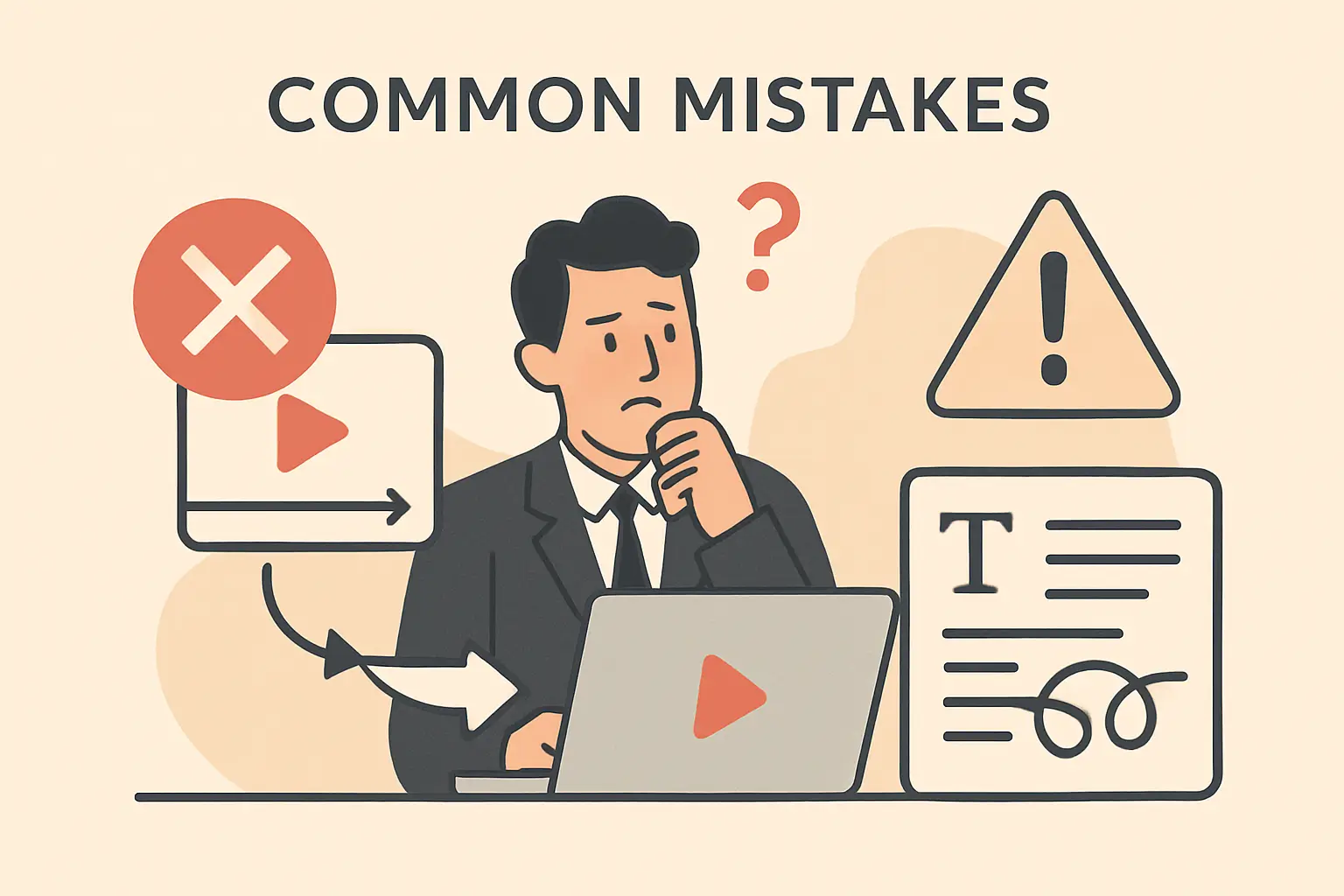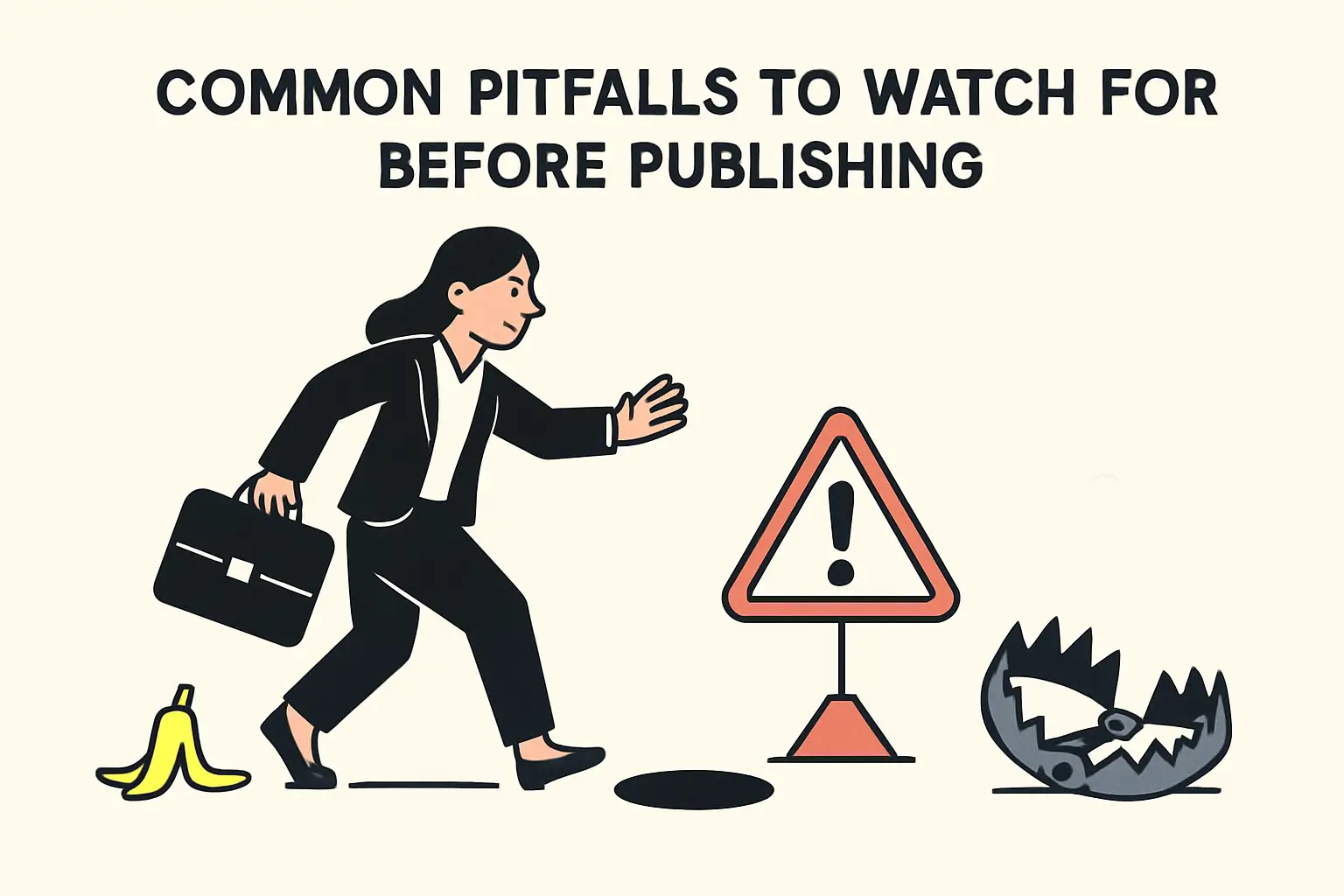Common Mistakes to Avoid When Converting Videos to Blog Posts

TL;DR: Converting videos into blog posts is an effective way to enhance SEO, reach a broader audience, and maximize content value. However, common mistakes include copying transcripts verbatim without editing, neglecting SEO and readability, losing the original message and tone, ignoring audience needs, and failing to add new value. To create successful blog posts from videos, it's important to structure content clearly, engage readers with a conversational tone, include visuals, and provide additional insights or resources. Proper editing, SEO optimization, and final proofreading are essential steps to avoid pitfalls and produce polished, impactful blog content.
Table of Contents
Why Convert Videos into Blog Posts?
Repurposing videos into blog posts is a smart strategy to boost your content’s impact. It'll help you:
- Boost Your SEO: Converting videos into keyword-rich posts helps search engines rank your content.
- Reach More People: Blog posts cater to those who prefer reading over watching videos.
- Drive More Traffic: Each post creates new entry points to your site.
- Maximize Content Value: Repurpose existing content to save time and increase monetization.
Tip: DemandMetrics reports companies that blog get 67% more leads. Repurposing videos taps into this growth without extra work.
Turning videos into blog posts amplifies your message, reaches new audiences, and strengthens your online presence—a win-win for content creators. For more info, see this ultimate guide on how to convert videos into blog posts.
Common Mistakes in Video-to-Blog Conversion

When you’re turning videos into blog posts, it’s easy to stumble into some classic traps that can tank your content’s impact. Let’s break down the most common errors and what not to do.
1. Copying the Transcript Word-for-Word
One of the biggest video transcript to blog post mistakes is simply pasting the video transcript as-is. Spoken language is naturally informal and full of filler words like “um,” “you know,” and repeated phrases. This makes the text clunky and hard to follow.
Think about it: would you want to read a blog post that sounds like someone talking off the cuff? Probably not. Without editing, your post will feel disjointed and unprofessional, turning off readers and confusing search engines.
2. Ignoring SEO and Readability
Skipping SEO optimization or failing to structure your post for easy reading is another common pitfall. Your blog needs clear headings, bullet points, and keywords to help both readers and search engines navigate your content.
3. Losing the Video’s Original Message and Tone
It’s tempting to just rewrite the transcript mechanically, but that risks losing the heart of your video. To keep the original vibe—whether it’s casual, authoritative, or inspiring—you need to:
- Understand the key points and emotional tone.
- Adapt the style to fit your blog’s voice.
- Use storytelling and direct quotes to keep it authentic.
Review your draft alongside the video to make sure you’re capturing the same energy and message.
4. Overlooking Your Audience’s Needs
If you ignore what your blog readers want, your post won’t resonate. That means fewer shares, lower engagement, and higher bounce rates. Always tailor your content to your audience’s preferences and pain points to keep them hooked.
Pro Tip: According to Ascend2, 72% of marketers say relevant content creation is the most effective SEO tactic. So, focusing on your audience’s needs isn’t just good practice—it’s essential for success.
5. Not Adding New Value
Finally, don’t just recycle the video content. Your blog post should add fresh insights, examples, or resources that make it worth reading even if someone has already watched the video. This extra effort turns your post from a simple transcript into a valuable resource.
Video to Blog Post Conversion Tips

The best way to convert video to article is having a focus on the structure of your content. Unlike videos, blog posts let readers jump around, skim, and digest information at their own pace. Here’s how to make that transition smooth and effective.
Structure Your Post for Easy Navigation
Start by breaking your content into clear, descriptive headings and subheadings (H2, H3). This helps readers quickly find what they want and improves your SEO. Kick off with a short, engaging introduction that sums up what the post covers. Then, keep paragraphs and sentences short to boost readability.
Use bullet points or numbered lists to highlight important info — they’re easier to scan than big blocks of text. And don’t forget to sprinkle in relevant images or visuals to complement your points and keep things lively.
Make It Engaging and Readable
To keep readers hooked, write in a conversational tone using active voice. Imagine you’re chatting with a friend who’s curious about your topic. Break up the text with subheadings and lists, and use formatting like bold or italics to spotlight key ideas.
Adding examples, anecdotes, or even rhetorical questions can make your post feel more personal and relatable. Visuals like charts or screenshots also help clarify complex points and add interest.
Pro tip: According to content marketing studies, blog posts with images get 94% more views than those without. So, don’t skimp on visuals! If you're interested in streamlining your process, check out the best video to blog AI tool to see how AI can assist in converting videos into engaging blog content.
Add Value Beyond the Video
Your blog post shouldn’t just be a transcript or summary of the video. Go the extra mile by including updated stats, fresh examples, or expert quotes that weren’t in the original. Offer downloadable resources like checklists or templates to give readers something tangible.
Summarize key takeaways for quick reference and address questions or objections your audience might have that the video missed. Optimizing your post for SEO and making it easy to scan will also help your content stand out and reach more people.
Streamline Your Workflow with the Right Tools
Converting videos to blog posts can feel overwhelming, but the right tools make it manageable:
|
Task |
Recommended Tools |
|---|---|
|
Transcription |
Video Blog AI, Otter.ai, Rev.com, Descript |
|
Editing & Polishing |
Video Blog AI, Grammarly, Hemingway Editor |
|
SEO & Formatting |
Video Blog AI, WordPress, Yoast SEO, Rank Math |
|
Project Management |
Video Blog AI, Trello, Asana |
Start by generating a transcript with a transcription service, then polish the text for clarity and style. Use SEO plugins to optimize keywords and metadata, and keep your workflow organized with project management apps. This combo saves time and keeps your content conversion on track.
Common Pitfalls to Watch for Before Publishing

Before hitting “publish,” watch out for these traps that can trip you up:
- Leftover transcription errors like filler words or false starts.
- Keyword stuffing that makes your post hard to read and hurts SEO.
- Missing or poorly written meta tags.
- Broken or irrelevant links.
- Images without proper formatting or credits.
- Posts that stray from your brand voice or audience expectations.
- Overly long paragraphs or dense blocks of text.
- Formatting issues on different devices.
- Typos and grammatical errors that slipped through.
Preview your post on desktop and mobile to catch any layout glitches. A final proofread (or two!) will help you maintain professionalism and keep your readers coming back for more.
Pro tip: Research indicates that well-structured information—with clear headings and bullet points—can improve retention by up to 40%. So, don’t skimp on formatting!
By giving your converted blog post this final round of attention, you’re not just repurposing content—you’re creating a polished, engaging piece that honors your original video and connects with your audience. Keep these tips in mind, and you’ll turn your videos into blog posts that truly work for you!
Frequently Asked Questions (FAQ)
Why is converting videos into blog posts beneficial?
Converting videos into blog posts boosts SEO, helps reach audiences who prefer reading, drives more website traffic, and maximizes content value by repurposing existing material.
What is a common mistake to avoid when converting videos to blog posts?
A common mistake is copying the transcript word-for-word without editing, which can result in a disjointed and unprofessional-looking post.
How can I make my blog post more engaging after converting from a video?
Make your blog post engaging by using a conversational tone, adding visuals, including examples or anecdotes, and structuring content with headings and lists for easy reading.
What should I do before publishing my video-to-blog post?
Before publishing, proofread for errors, check formatting on different devices, optimize SEO elements like meta tags, and ensure all links and images are properly formatted and relevant.
How can I add value to my blog post beyond the video content?
Add value by including updated statistics, new examples, expert quotes, downloadable resources, and summaries that provide additional insights not covered in the original video.
